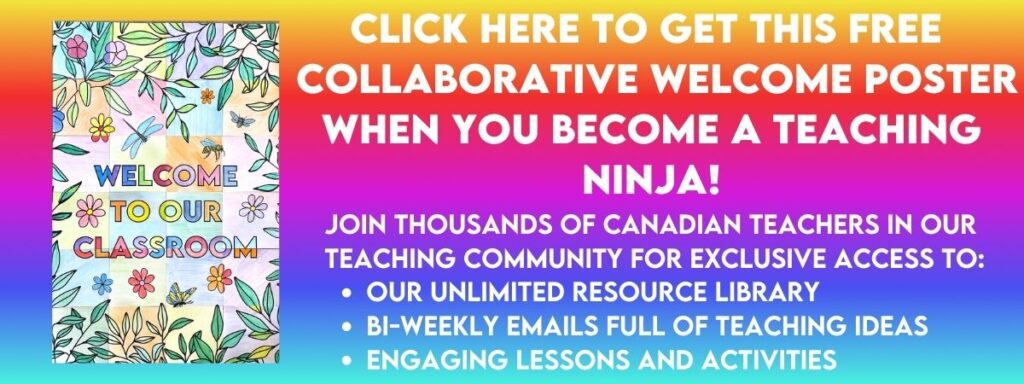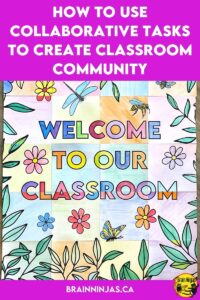
One of the most effective classroom management strategies is the classroom community you build with your students. We start our school year with collaborative tasks to help students get to know each other. These activities help students learn to communicate and build trust. Collaborative tasks help students learn to work together toward the classroom community they want to achieve.
Come learn more about how we use collaborative tasks in our classroom.
Understanding Group Roles in Collaborative Tasks
During collaborative tasks, it’s important that students understand their roles. Some tasks require students to take on specific roles like leading, drawing or managing time. Sometimes all the students in the group will have the same roles, while other tasks may require students to take on different jobs.
One way we help students learn to manage group roles is through our Group Roles and Processes Unit. Students work through different tasks to learn how groups work. You can find the Group Roles and Processes Unit in our TpT Store and BN Shop.
If you’re looking for more ways to help your students work in group situations, try reading How to Teach Students to Work in Groups.

Introverts and Collaborative Tasks
As an introvert, games and icebreakers that require me to be loud or extroverted are an immediate turn-off. That doesn’t mean I don’t enjoy collaborating or working with a team.
Collaborative tasks need to think of all your different students and their needs. This means some will be more gamelike (loud and fast) while others are more project-based (slower with students completing individual tasks).
Being introverted does not mean students don’t want opportunities to perform or collaborate. It just means some consideration for their needs. You can read more about supporting your introverted learners in our post 3 Ways to Support Introverts in Your Classroom.
Teamwork Focused Collaborative Tasks
Teamwork tasks are great for helping your students build relationships. When students learn to master teamwork, they learn to complete tasks more efficiently, using each student’s special gifts and strengths. A little bit of competition between teams helps students learn to win or lose graciously. Teamwork helps students feel they belong.
Collaborative tasks can help you as a teacher learn new skills and traits of your students. Which students suddenly become leaders? Do you have students will artistic talents or amazing writing skills? Which students encourage others? Are there any natural teachers?
We put together several of our collaborative tasks in a set of activities that encourage teamwork, cooperation and communication. Find our Classroom Community Unit in our TpT Store and BN Shop.
Here are some simple teamwork games to try.
Fox, Chicken and Rice
Put students in small groups and give them three different coloured items. They represent a fox, rice and a chicken. Place the items to one side.
Explain that they need to get the three items from one side to the other. The challenge is that they can only move one item at a time from one side or the other. The fox cannot be left with the chicken because it will eat it. The chicken cannot be left with the rice because it will eat it.
Hint: Items can be moved back and forth from side to side more than once.
Stringy Shapes
Put your students in a circle. Use a piece of yarn or string long enough to go all the way around and be tied together, making a circle. Have students hold the string. Call out different shapes. Students will stay attached to the string but will move to make the shape.
Make it more challenging by not allowing students to speak at all. Or have all but one student close their eyes. The student, with their eyes open, can direct others. Use more complicated shapes like hexagons or random shapes you draw on the board.
You can also divide the class in half and have two groups race to see who can make the shapes first.
Blindfolded Scavenger Hunt
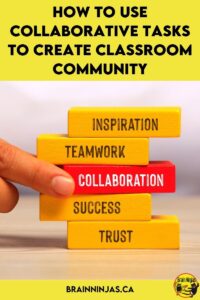
This activity requires a big open space like a field or gymnasium. Choose some random objects that can be placed on the ground and won’t be broken if dropped or kicked. You will need the same number of individual objects for each group playing. You will need the same number of groups of objects as members in a team. So, if you have four teams of five, you will need 20 objects (four of each). We recommend you only choose enough teams so that students won’t bump into each other when playing.
Remind students to walk slowly and carefully when blindfolded.
Divide the groups into teams. Put the team in a line facing the objects that are scattered all over the ground. The first person in the line will be the caller. The second person will be the searcher. The searcher is blindfolded. The caller tells the searcher where to go to pick up one object. When they have picked up the object, the caller must tell them how to get back to the group.
The caller goes to the end of the line. The searcher becomes the caller. The next person in the line becomes the next searcher taking the blindfold. The game continues until all the objects are picked up.
As the objects are brought back, the caller will have the added challenge of hanging onto them. They cannot continue speaking if they drop anything.
Make it more challenging by having awkward objects to hold or pick up.
Collaborative Posters are Easy and Fun
Have you ever used a collaborative poster with your students? Students colour individual pieces. They make one big poster. Put the pieces together like a puzzle.
Collaborative posters are a lower-risk activity for introverts or students who have difficulty working with others. We use them in a variety of ways. Some posters have learning attached to them. Others are simply for fun or to kill a little time during transitions. They also make easy sub plans.
Want to try a free collaborative poster? We created this simple one just for you. Find it in our Resource Library. Alternatively, we can send it directly to your inbox when you sign up for our email list. We also have a French version, which can be found by following the link.
Check Out Some of Our Collaborative Posters
We’ve created collaborative poster sets for different topics. Each set comes with instructions on how to use them with your class. Our sets are designed to include 18, 24, and 36 pieces, so they’ll work with most class sizes. We’ve even included follow-up activities to extend the learning or keep your early finishers busy.
Working Together Collaborative Poster is a great back-to-school poster. You can find it in our TpT Store or BN Shop.
Pink Shirt Day Collaborative Poster is a simple poster to highlight this anti-bullying observation. It is available in our TpT Store or BN Shop.
National Indigenous Veterans Day is observed on November 8 each year in Canada. This poster set highlights some of the challenges for Indigenous veterans, along with some notable names. Take a look at it in our TpT Store or BN Shop.
Diwali Collaborative Poster features henna painting, diyas and rangolis. Find it in our TpT Store or BN Shop.
Eid Collaborative Poster includes the words Eid Mubarak so it can be used for Eid al-Fitr or Eid ul Adha. It is in our TpT Store or BN Shop.
Regions of Alberta Collaborative Poster Set is a rare format for us. Not only does it include a poster set for the overall geographical regions of Alberta, it includes an individual poster for each region. That means there are seven posters included (and yes, each comes with 18, 24, and 36 pieces and the follow-up activities). This is a great way to introduce the different geographical regions of Alberta. Find it in our TpT Store or BN Shop.
More posters are being added all the time. Search on our TpT Store or our Brain Ninjas Shop.
Collaborative Research Projects Have the Teamwork Built In
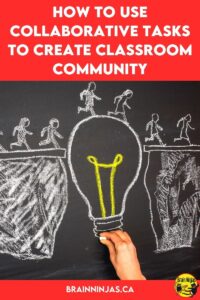
Instead of having students do their own research, have you ever had all your students do the research together? It can be a great way to gather a lot of information in a short amount of time. Since students are only looking for small bits of information, they don’t get overwhelmed with trying to find and keep track of all the information.
Try this simple task. Make a list of the provinces and territories of Canada along one side of your whiteboard. Divide up your students so there are just a few for each of the provinces and territories. Give each group books or a device where they will be able to find information about their province or territory. Ask each small group (our groups usually have 1-2 students) to find the capital city, the flag and the general population of their province or territory. Make your list into a chart with 2 columns. One column will be the name of the capital city, and the other for the population.
Give them 5-10 minutes to find their information. When they find the capital city or population, they can add them directly to the chart. When they find the flag, they can just keep the picture available to share.
Once students have found the information, review it. Point out how quickly they were able to find a lot of information.
If your students struggle with finding information, try reading Disguise Research Skills as a Scavenger Hunt.
Our Collaborative Research Projects
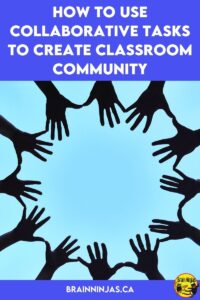
We tend to do a lot of collaborative research in our class as it’s an effective way to collect information without a lot of strain on students.
One of our favourites is a project where students collect information about different First Nations, Metis and Inuit people and how they lived in the past. The information is compared to how they live in modern day. There are several activities before students start doing the research to help them think about the differences between living in the past and now.
Our Indigenous People in the Past: A Collaborative Research Project takes a few weeks to complete. We’ve included background information for you to get started. There are also photos of student work. You can find the Indigenous People in the Past: A Collaborative Research Project in our TpT Store and BN Shop.
What are some of the ways you encourage students to work together? Let us know in the comments below.

